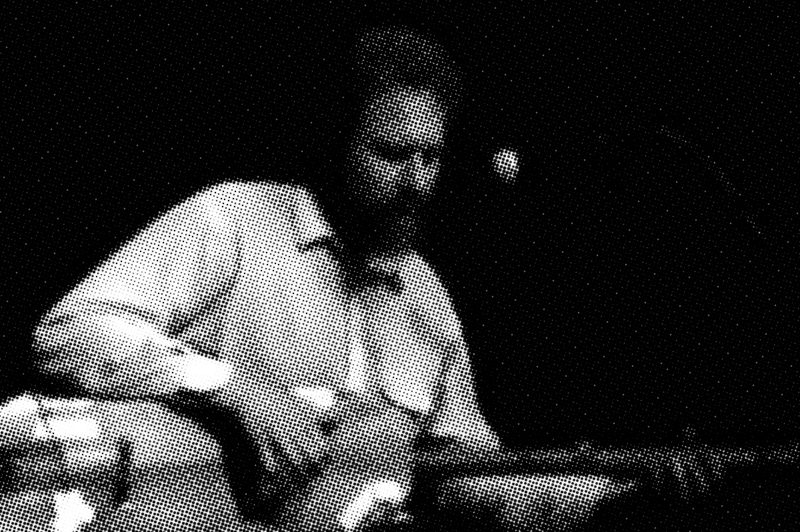Joshua Abrams

Wouter Van Haelemeesch
One of my first and obvious question is how you stumbled upon the guimbri?
Joshua Abrams
I first heard the instrument when I was a teenager on a television program called “Night Music.” Many years later I found out it was Hassan Hakmoun playing. In my twenties I was drawn back to the instrument hearing Maleem Mahmoud Ghania on Pharoah Sander’s beautiful record, “The Trance of the Seven Colors”. Something about the sound of the instrument spoke very directly to me. In 1998 I had a chance to go to Morocco and the guimbri helped guide my journey. I had the chance to hear the Gnawa’s music in person in Marrakesh, in the Jemaa El Fina, and in Essaouira I got to learn some technique from hanging out with M’allem Najib Soudani.
WvH
Was it easy to incorporate the instrument into your music?
JA
It took time. I wanted to find a new context for the instrument that arrived at a similar place in terms of function, but aesthetically had its own distinct approach. I aim to deal with structures that focus on continuance through constant gradual change. First I needed to develop proficiency on the instrument. Eventually I began bringing the instrument into different contexts. The great drummer Hamid Drake has always been a source of encouragement and he asked me to record a duet with Fred Anderson on the record “From the River to the Ocean”. Over time, I started writing music for the instrument and putting together different ensembles to play live. This led to 2010’s recording, “Natural Information”.
WvH
How do you tune it? I read somewhere that the Gnawa people have very specific tunings that remains a mystery for people outside their community?
JA
I tune the instrument to Ab, I’ve heard traditional music where it is tuned to A or G. Regarding secret tunings, being an outsider I would not know, and if I did I would not say.
WvH
One of the key ideas behind the festival is to explore the link between Western underground music and folk traditions all over the world. For instance: the use of drones, the 'rawness' of sound or the trance inducing element. What is your take on this link.
JA
In the West there is sometimes a yearning for more traditional ways since we are so immersed in the ideology of commerce and lean so heavily on science to guide our way. Traditional music sometimes speak to other parts of our selves or other areas of our consciousness.
There are many theories. Music’s potential to heal is sometimes considered exotic but most lovers of music have experienced some form of joy or relief from sorrow through music at some time in their lives. Perhaps that can be understood as a simple form of healing as well. Attempting to make music that demands concentration and has the potential lift the spirit has been a goal of my practice for many years. In some ways that is what drew me to playing jazz when I was a teenager.
Natural Information Society’s music is an extension of my experiences with many types of music including jazz and traditional music as well as minimalism (which also draws heavily from traditional musics), krautrock and even hip hop. There is a debt to bridge builders like Don Cherry, Malachi Favors and Hamza El Din, who expanded notions of incorporating the influence and instruments from a foreign place and making something personal with them.
WvH
One of the key ideas behind the festival is to explore the link between Western underground music and folk traditions all over the world. For instance: the use of drones, the 'rawness' of sound or the trance inducing element. What is your take on this link.
JA
In the West there is sometimes a yearning for more traditional ways since we are so immersed in the ideology of commerce and lean so heavily on science to guide our way. Traditional music sometimes speak to other parts of our selves or other areas of our consciousness.
There are many theories. Music’s potential to heal is sometimes considered exotic but most lovers of music have experienced some form of joy or relief from sorrow through music at some time in their lives. Perhaps that can be understood as a simple form of healing as well. Attempting to make music that demands concentration and has the potential lift the spirit has been a goal of my practice for many years. In some ways that is what drew me to playing jazz when I was a teenager.
Natural Information Society’s music is an extension of my experiences with many types of music including jazz and traditional music as well as minimalism (which also draws heavily from traditional musics), krautrock and even hip hop. There is a debt to bridge builders like Don Cherry, Malachi Favors and Hamza El Din, who expanded notions of incorporating the influence and instruments from a foreign place and making something personal with them.